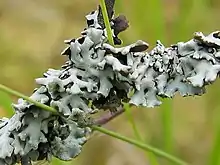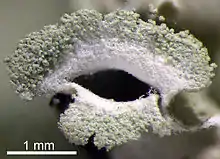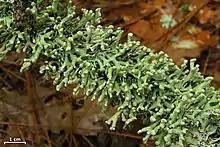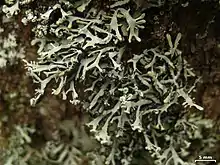Hypogymnia
Hypogymnia is a genus of foliose lichens in the family Parmeliaceae. They are commonly known as tube lichens, bone lichens, or pillow lichens. Most species lack rhizines (root-like attachment organs on the lower surface) that are otherwise common in members of the Parmeliaceae, and have swollen lobes that are usually hollow. The lichens usually grow on the bark and wood of coniferous trees.
| Hypogymnia | |
|---|---|
 | |
| Hypogymnia physodes | |
| Scientific classification | |
| Kingdom: | Fungi |
| Division: | Ascomycota |
| Class: | Lecanoromycetes |
| Order: | Lecanorales |
| Family: | Parmeliaceae |
| Genus: | Hypogymnia (Nyl.) Nyl. (1896) |
| Type species | |
| Hypogymnia physodes (L.) Nyl. (1896) | |
| Synonyms | |
| |
Hypogymnia was created by botanist William Nylander, first as a subgenus of Parmelia in 1881, and 15 years later as a distinct genus of two species, including the widespread and common type species, Hypogymnia physodes. It has since grown to about 90 recognized species. Hypogymnia has a centre of biodiversity in China, where many of its species are found.
Taxonomy
Hypogymnia was first created as subgenus of Parmelia by Finnish botanist William Nylander in 1881. He associated it with the species Parmelia physodem (which ultimately became the type species, Hypogymnia physodes), noting the lack of rhizines as the characteristic distinguishing it from Parmelia.[1] Nylander later promoted it to generic status in 1896. At this time, the genus contained only two species: Hypogymnia pertusa (currently named Menegazzia terebrata)[2] as well as the type species.[3] For many decades afterwards, the genus did not have widespread recognition, as most lichenologists preferred to include the "hypogymnioid" lichens in the classic form genus Parmelia.[4] In 1951 Hildur Krog considered the morphology and chemistry of this group of species to be distinctive and reinstated the genus Hypogymnia. Krog included four subgenera, including H. subg. Cavernularia and H. subg.Everniiformes.[5] These later became accepted as distinct genera (the former only temporarily; see synonymy below), the latter under the name Pseudevernia.[4]
In 1974, Krog published an account of three Northern Hemisphere Hypogymnia species that grow on acid rock in arctic and alpine habitats. These species, namely H. atrofusca, H. intestiniformis, and H. oroarctica, make up the H. intestiniformis group.[6] This biologically discontinuous assemblage of species was segregated from Hypogymnia by Trevor Goward under the genus name Brodoa in 1986. It differs from Hypogymnia in its compact medulla, larger spores and different cortical structure.[4]
Hypogymnia is classified in the Parmeliaceae. The family Hypogymniaceae has been proposed in the past to contain the genus and other similar hypogymnioid lichens,[7] but this taxonomic arrangement has not been widely accepted by other taxonomists.[8] For example, Krog argued that no critical characters had been suggested that could be used as a defining familial characteristic.[9] In the Parmeliaceae, Hypogymnia belongs to the hypogymnioid clade along with the genera Arctoparmelia, Brodoa, and Pseudevernia.[10] All of these genera share the common characteristic of having a loosely compact medulla.[11]
Hypogymnia lichens are commonly known as "tube lichens", "bone lichens", or "pillow lichens".[12]
Synonymy
Synonyms of Hypogymnia are Cavernularia, created by Gunnar Degelius in 1937,[13] and Ceratophyllum, created by Maurice Choisy in 1951. Cavernularia contained two hypogymnoid species, C. lophyrea and C. hultenii. This species pair has an array of pronounced but small depressions in the lower surface, instead of the smooth or irregularly wrinkled surface typical of Hypogymnia;[14] Degelius called these minute cavities (about 0.1 mm diameter) "cavernulae".[13] The two Cavernularia species are otherwise similar to Hypogymnia in terms of overall morphology, microstructure of the apothecia, and chemistry. Molecular analysis showed that Cavernularia needed to be subsumed into Hypogymnia in order for the latter genus to be monophyletic. This suggested synonymy had already been proposed several decades earlier by Veli Räsänen in 1943 and Hildur Krog in 1952, but not adopted by later authors, including Krog herself.[14]
Description
.jpg.webp)
Hypogymnia is a genus of medium to large foliose lichens. They are typically greenish grey to brownish grey in colour;[12] some species are yellowish (from usnic acid).[8] The thallus comprises more or less inflated but hollow (tube-like) lobes. These lobes often have a perforation at the tip. The colour of the ceiling of the tubes (the medullary surface) is dark brown or white, and is often used as a characteristic to distinguish between species. The lower surface of the tube is black with a smooth or wrinkled texture.[12]

Rhizines are root-like attachment organs on the lower surface of a lichen thallus, made of elongated strands of hyphae; a shorter version of this attachment organ is called a hapter. Although many recent lichen floras and manuals describe Hypogymnia as lacking rhizines, a 2015 study challenges the universality of this assertion. In the study, researchers studied a large number of Hypogymnia collections, representing 72 species as well as 64 type specimens. They found that rhizines and hapters were occasionally present on the lower surface of 35 species. Two types of attachment organs are found: slender rhizines with fine and tapering tips (found in H. krogiae and H. subfarinacea), and the more common hapters, which are thick with broken tips. Both types are dark brown to black and usually the same colour as the lower surface. In all cases where these attachment organs are found, however, they are few in number and are sparsely distributed on the lower thallus surface.[11]
The apothecia of Hypogymnia are lecanorine in form with a constricted base and are often raised or shaped like an urn. The apothecial discs are red-brown and typically concave. Ascospores are colourless, ellipsoid, and number eight per ascus.[12] They are relatively small, less than 9 μm long.[14] Pycnidia are black and appear as small dots on the surface of the lobes.[12] The cortex contains atranorin (responsible for the grey colour),[8] while the medullae of most species have physodic acid, and some species contain other orcinol and beta-orcinol depsidones, including protocetraric acid and physodalic acid.[12]
The genus Menegazzia contains species that could be confused with Hypogymnia; Menegazzia, however, has perforations on the upper lobe surface, unlike Hypogymnia. Other superficially similar genera, such as Brodoa and Allantoparmelia, can be distinguished from Hypogymnia by their solid lobes.[12]
Habitat and distribution
Hypogymnia species usually grow on bark and wood, particular that of conifers. Less frequently, they are found on rock or mossy soil.[12] The genus has been recorded on all continents except Antarctica. In tropical to subtropical locations, Hypogymnia appears to be restricted to high elevations.[14] Seventeen species are recorded from the Himalayan region of India and Nepal,[15] while 31 species are present in North America.[8] Southwestern China is a centre of biodiversity for the genus, as more than 40 species occur there.[16] It is one of the few large Parmeliaceae genera that has main distribution in the Northern Hemisphere.[17]
Uses
Hypogymnia physodes has been used as a biomonitor for several applications. Examples include monitoring atmospheric nitrogen and sulphur deposition in Norway,[18] the accumulation of mercury downwind of chloralkali plant in Wisconsin,[19] and pollution from several toxic heavy metal elements following the closure of a large mine waste dump close to Zlatna, Romania.[20] It was also used to help evaluate the levels of radionuclides deposited in the environment after the East Urals (1957) and Chernobyl (1988) nuclear accidents.[21] H. tubulosa is an indicator species of old-growth forests.[22]
In 15th-century Europe, Hypogymnia physodes was one component (in addition to Evernia prunastri and Pseudevernia furfuracea) of the popular drug "Lichen quercinus virdes".[23] In Traditional Chinese Medicine, Hypogymnia hypotrypa (Folk name: 黄袋衣 (huáng dài yī), 粉黄袋梅衣 (fěn huáng dài méi yī)) is used for "dim vision, bleeding from uterus, bleeding from external injury, chronic dermatitis, and sores."[24]
Species
About 90 species are recognized in the genus.[25]
.jpg.webp)
.JPG.webp)
.jpg.webp)
_Ohlsson_713764_crop.jpg.webp)
.jpg.webp)
.jpg.webp)
.jpg.webp)


- Hypogymnia amplexa Goward, Björk & T.B.Wheeler (2011)[26]
- Hypogymnia arcuata Tchaban. & McCune (2001)[27] – east Asia
- Hypogymnia asahinae K.Yoshida (2001)[28] – Japan
- Hypogymnia australica Elix (1989)[29]
- Hypogymnia beringiana (Krog) McCune (2008) – Alaska; Russia
- Hypogymnia billardierei (Mont.) Filson (1970)
- Hypogymnia bryophila McCune (2002)[30] – Portugal
- Hypogymnia bulbosa McCune & Li S.Wang (2003)[31] – China
- Hypogymnia canadensis Goward & McCune (2007)[32] – North America
- Hypogymnia capitata McCune (2014)[16] – China
- Hypogymnia castanea McCune & Krog (2008)[33] – Alaska; Far East Russia
- Hypogymnia congesta McCune & C.F.Culb. (2003)[31] – China
- Hypogymnia crystallina McCune, Divakar & Upreti (2012)[15] – Himalayas
- Hypogymnia dichroma Goward (2012)[34] – American Cordillera
- Hypogymnia diffractaica McCune (2003)[31] – China
- Hypogymnia duplicata (Sm.) Räsänen (1967)
- Hypogymnia elgonensis C.W.Dodge (1959)[35] – Africa
- Hypogymnia elongata (Hillmann) Rass. (1956)
- Hypogymnia enteromorphoides Elix (1980)[7]
- Hypogymnia farinacea Zopf (1907)
- Hypogymnia fistulosa McCune & Krog (2008)[33] – Aleutian Islands; other islands in the Bering Sea; Seward Peninsula
- Hypogymnia flavida McCune & Obermayer (2001)[36] – China
- Hypogymnia fragillima (Hillmann ex Sato) Rass. (1956)
- Hypogymnia fujisanensis (Asahina) Kurok. (1971)
- Hypogymnia gracilis McCune (2002)[37]
- Hypogymnia guadalupensis McCune (2002)[38]
- Hypogymnia hengduanensis J.C.Wei (1984)[39]
- Hypogymnia heterophylla L.H.Pike (1982)[40] – North America
- Hypogymnia hokkaidensis Kurok. (1971)[41] – Japan
- Hypogymnia hultenii (Degel.) Krog (1951)
- Hypogymnia hypotrypa (Nyl.) Rass. (1956)
- Hypogymnia imshaugii Krog (1968)[42] – Alaska
- Hypogymnia inactiva (Krog) Ohlsson (1973)
- Hypogymnia incurvoides Rass. (1967)[43]
- Hypogymnia inflata C.W.Dodge (1959)[35] – Africa
- Hypogymnia irregularis McCune (2011)[44] – southwest China; Nepal; Japan
- Hypogymnia kangdingensis (J.C.Wei) J.B.Chen & J.C.Wei (1989)
- Hypogymnia kiboensis C.W.Dodge (1959)[35] – Africa
- Hypogymnia kosciuskoensis Elix (1980)[7] – Australia
- Hypogymnia krogiae Ohlsson (1973)[45] – North America
- Hypogymnia laccata J.C.Wei & Y.M.Jiang (1980)[46] – Tibet
- Hypogymnia laminisorediata D.Hawksw. & Poelt (1973)[47] – Greece; Morocco
- Hypogymnia laxa McCune (2003)[31] – China
- Hypogymnia lijiangensis J.B.Chen (1994)
- Hypogymnia lugubris (Pers.) Krog (1968)
- Hypogymnia lophyrea (Ach.) Krog (1951)
- Hypogymnia macrospora (J.D.Zhao) J.C.Wei (1991)
- Hypogymnia madeirensis (Tav.) D.Hawksw. (1973)
- Hypogymnia magnifica X.L.Wei & McCune (2010)[48] – China
- Hypogymnia metaphysodes (Asahina) Rass. (1967)
- Hypogymnia minilobata McCune & C.L.Schoch (2009)[49] – United States
- Hypogymnia mollis L.H.Pike & Hale (1982)[40] – North America
- Hypogymnia mundata (Nyl.) Oxner ex Rass. (1956)
- Hypogymnia nikkoensis (Zahlbr.) Rass. (1967)
- Hypogymnia nitida McCune & Li S.Wang (2014)[16] – China
- Hypogymnia obscurata (Bitter) Räsänen (1943)
- Hypogymnia occidentalis L.H.Pike (1982)[40] – Oregon
- Hypogymnia oceanica Goward (1988)[50] – North America
- Hypogymnia papilliformis McCune, Tchaban. & X.L.Wei (2015)[51] – Russian Far East; China
- Hypogymnia pectinatula (Zahlbr.) Elix (1989) – Java; Papua New Guinea; Philippines; North Borneo
- Hypogymnia pendula McCune & Li S.Wang (2014)[16] – China
- Hypogymnia physodes (L.) Nyl. (1896)
- Hypogymnia protea Goward, T.Sprib. & Ahti (2012)[34] – American Cordillera
- Hypogymnia pruinoidea X.L.Wei & J.C.Wei (2012)[52] – China
- Hypogymnia pruinosa J.C.Wei & Y.M.Jiang (1980)[46] – Tibet
- Hypogymnia pseudobitteriana (D.D.Awasthi) D.D.Awasthi (1971)
- Hypogymnia pseudocyphellata McCune & E.P.Martin (2003)[31] – China
- Hypogymnia pseudoenteromorpha M.J.Lai (1980)[53] – Japan
- Hypogymnia pseudophysodes (Asahina) Rass. (1967)
- Hypogymnia pseudopruinosa X.L.Wei & J.C.Wei (2006)[54] – China
- Hypogymnia pulchrilobata (Bitter) Elix (1980)
- Hypogymnia pulverata (Nyl.) Elix (1980)
- Hypogymnia recurva Goward, Björk & Hollinger (2010)[55] – North America
- Hypogymnia rhodesiana C.W.Dodge (1959)[35] – Africa
- Hypogymnia sachalinensis Tchaban. & McCune (2002)[27] – east Asia
- Hypogymnia salsa Goward (2012)[34] – American Cordillera
- Hypogymnia saxicola McCune & Li S.Wang (2014)[16] – China
- Hypogymnia schizidiata McCune (2002)[56]
- Hypogymnia sikkimensis G.P.Sinha & Elix (2003)[57] – Sikkim, India
- Hypogymnia sinica J.C.Wei & Y.M.Jiang (1980)[46] – China
- Hypogymnia stricta (Hillmann) K.Yoshida (2001) – China; Japan; Taiwan
- Hypogymnia subarticulata (J.D.Zhao, L.W.Hsu & Z.M.Sun) J.C.Wei & Y.M.Jiang (1986)
- Hypogymnia subcrustacea (Flot.) Kurok. (1971)
- Hypogymnia subduplicata (Rass.) Rass. (1973)
- Hypogymnia subfarinacea X.L.Wei & J.C.Wei (2006)[54] – China
- Hypogymnia submundata (Oxner) Rass. (1967)
- Hypogymnia subobscura (Vain.) Poelt (1962)
- Hypogymnia subphysodes (Kremp.) Filson (1970)
- Hypogymnia subvittata (J.D.Zhao) J.C.Wei (1991)
- Hypogymnia taiwanalpina M.J.Lai (1980)[53] – Taiwan
- Hypogymnia tasmanica Elix (1989)[29]
- Hypogymnia tavaresii D.Hawksw. & P.James (1973)[47] – Canary Islands
- Hypogymnia tenuispora McCune & Li S.Wang (2014)[16] – China
- Hypogymnia thomsoniana (Müll.Arg.) D.D.Awasthi (1985)
- Hypogymnia tubularis (Taylor) Elix (1980)
- Hypogymnia tubulosa (Schaer.) Hav. (1918)
- Hypogymnia turgidula (Bitter) Elix (1980)
- Hypogymnia verruculosa Goward (2012)[34] – American Cordillera
- Hypogymnia vittata (Ach.) Parrique (1898) – Asia; Europe; North America
- Hypogymnia wattiana (Müll.Arg.) D.D.Awasthi (1985)
- Hypogymnia wilfiana Goward, T.Sprib. & Ahti (2010)[55] – North America
- Hypogymnia yunnanensis Y.M.Jiang & J.C.Wei (1990) – China
- Hypogymnia zeylanica (R.Sant.) D.D.Awasthi & Kr.P.Singh (1971) – Sri Lanka
Hypogymnia contains three species pairs: H. krogiae and the sorediate counterpart H. incurvoides, H. minilobata and the sorediate H. mollis, and H. lophyrea and the sorediate H. hultenii.[14]
References
- Nylander, William (1881). "Addenda nova ad Lichenographium europaeam". Flora oder Botanische Zeitung. 34: 537.
- "Record Details: Hypogymnia pertusa (Schaer.) Nyl". Index Fungorum. Retrieved June 3, 2020.
- Nylander, W. (1896). Les Lichens des Environs de Paris (in French). Paris: Typographye Paul. Schmidt. pp. 39, 139.
- Goward, Trevor (1986). "Brodoa, a new lichen genus in the Parmeliaceae". Bryologist. 89 (3): 219–223. doi:10.2307/3243288. JSTOR 3243288.
- Krog, Hildur (1951). "Microchemical studies on Parmelia". Nytt Magazin for Naturvidenskapene. 88: 57–85.
- Krog, Hildur (1974). "Taxonomic studies in the Hypogymnia intestiniformis complex". Lichenologist. 6 (2): 135–140. doi:10.1017/S0024282974000211.
- Elix, John A. (1979). "A taxonomic revision of the lichen genus Hypogymnia in Australasia". Brunonia. 2 (2): 175–245. doi:10.1071/BRU9790175.
- Elvebakk, Arve (2011). "A review of the genus Hypogymnia (Parmeliaceae) in Chile". Bryologist. 114 (2): 379–388. doi:10.1639/0007-2745-114.2.379. JSTOR 41289794. S2CID 85422410.
- Krog, Hildur (1982). "Evolutionary trends in foliose and fruticose lichens of the Parmeliaceae". Journal of the Hattori Botanical Laboratory. 52: 303–311.
- Crespo, Ana; Lumbsch, H. Thorsten; Mattsson, Jan-Eric; Blanco, Oscar; Divakar, Pradeep K.; Articus, Kristina; Wiklund, Elisabeth; Bawingan, Paulina A.; Wedin, Mats (2007). "Testing morphology-based hypotheses of phylogenetic relationships in Parmeliaceae (Ascomycota) using three ribosomal markers and the nuclear RPB1 gene". Molecular Phylogenetics and Evolution. 44 (2): 812–824. doi:10.1016/j.ympev.2006.11.029. PMID 17276700.
- Wei, Xin-Li; Chen, Kai; Lumbsch, H. Thorsten; Wri, Jiang-Chun (2015). "Rhizines occasionally occur in the genus Hypogymnia (Parmeliaceae, Ascomycota)". Lichenologist. 47 (1): 69–75. doi:10.1017/S0024282914000541.
- Brodo, Irwin M.; Sharnoff, Sylvia Duran; Sharnoff, Stephen (2001). Lichens of North America. Yale University Press. p. 345. ISBN 978-0300082494.
- Degelius, G. (1937). "Lichens from southern Alaska and the Aleutian Islands, collected by Dr. E. Hultén". Meddelelser från Götebörgs Botaniska Trädgård. 12: 105–144.
- Miadlikowska, Jolanta; Schoch, Conrad L.; Kageyama, Stacie A.; Molnar, Katalin; Lutzoni, François; McCune, Bruce (2011). "Hypogymnia phylogeny, including Cavernularia, reveals biogeographic structure". Bryologist. 114 (2): 392–400. doi:10.1639/0007-2745-114.2.392. S2CID 86330534.
- McCune, B.; Divakar, P. K.; Upreti, D. K. (2012). "Hypogymnia in the Himalayas of India and Nepal". Lichenologist. 44 (5): 595–609. doi:10.1017/S0024282912000321.
- McCune, B; Wang, LS (2014). "The lichen genus Hypogymnia in southwest China" (PDF). Mycosphere. 5 (1): 27–76. doi:10.5943/mycosphere/5/1/2.

- Thell, Arne; Crespo, Ana; Divakar, Pradeep K.; Kärnefelt, Ingvar; Leavitt, Steven D.; Lumbsch, H. Thorsten; Seaward, Mark R. D. (2012). "A review of the lichen family Parmeliaceae – history, phylogeny and current taxonomy". Nordic Journal of Botany. 30 (6): 641–664. doi:10.1111/j.1756-1051.2012.00008.x.
- Bruteig, Inga E. (1993). "The epiphytic lichen Hypogymnia physodes as a biomonitor of atmospheric nitrogen and sulphur deposition in Norway". Environmental Monitoring and Assessment. 26 (1): 27–47. doi:10.1007/BF00555060. PMID 24225896. S2CID 26051144.
- Makholm, M. M.; Bennett, J. P. (1998). "Mercury accumulation in transplanted Hypogymnia physodes lichens downwind of Wisconsin chlor-alkali plant". Water, Air, and Soil Pollution. 102 (3/4): 427–436. Bibcode:1998WASP..102..427M. doi:10.1023/A:1004977717769. S2CID 94532506.
- Rusu, A.-M.; Jones, G.C.; Chimonides, P.D.J.; Purvis, O.W. (2006). "Biomonitoring using the lichen Hypogymnia physodes and bark samples near Zlatna, Romania immediately following closure of a copper ore-processing plant". Environmental Pollution. 143 (1): 81–88. doi:10.1016/j.envpol.2005.11.002. PMID 16368174.
- Biazrov, Lev G. (1994). "The radionuclides in lichen thalli in Chernobyl and East Urals areas after nuclear accidents". Phyton. 34 (1): 85–95.
- Whelan, Paul (2011). Lichens of Ireland – an illustrated introduction to over 250 species. Cork: Collins Press. p. 66. ISBN 978-1-84889-137-1.
- Mitrovic, Tatjana; Stamenkovic, Slaviša; Cvetkovic, Vladimir; Radulovic, Niko; Mladenovic, Marko; Stankovic, Milan (2014). "Platismatia glaucia and Pseudevernia furfuracea lichens as sources of antioxidant, antimicrobial and antibiofilm agents". EXCLI Journal. 13: 938–953. PMC 4464406. PMID 26417313.
- Crawford, Stuart (2019). "Lichens Used in Traditional Medicine". In Ranković, Branislav (ed.). Lichen Secondary Metabolites. Bioactive Properties and Pharmaceutical Potential (2 ed.). Springer Nature Switzerland AG. p. 66. ISBN 978-3-030-16813-1.
- Wijayawardene, Nalin; Hyde, Kevin; LKT, Al-Ani; S, Dolatabadi; Stadler, Marc; Haelewaters, Danny; Tsurykau, Andrei; Mesic, Armin; Navathe, Sudhir; Papp, Viktor; Oliveira Fiuza, Patrícia; Vázquez, Víctor; Gautam, Ajay; Becerra, Alejandra G.; Ekanayaka, Anusha; K. C., Rajeshkumar; Bezerra, Jadson; Matočec, Neven; Maharachchikumbura, Sajeewa; Suetrong, Satinee (2020). "Outline of Fungi and fungus-like taxa". Mycosphere. 11: 1060–1456. doi:10.5943/mycosphere/11/1/8.
- Lumbsch, H. T.; Ahti, T.; Altermann, S.; De Paz, G. A.; Aptroot, A.; Arup, U.; et al. (2011). "One hundred new species of lichenized fungi: a signature of undiscovered global diversity". Phytotaxa. 18 (1): 64. doi:10.11646/phytotaxa.18.1.1.
- McCune, Bruce; Tchabanenko, Svetlana (2001). "Hypogymnia arcuata and H. sachalinensis, two new lichens from east Asia". Bryologist. 104 (1): 146–150. doi:10.1639/0007-2745(2001)104[0146:HAAHST]2.0.CO;2.
- Yoshida, K.; Kashiwadani, H. (2001). "Typification of taxa of Hypogymnia (Parmeliaceae) described from Japan and Sakhalin". Bulletin of the National Science Museum Tokyo. 27 (2–3): 35–46.
- Elix, John A.; Jenkins, Gillian A. (1989). "New species and new records of Hypogymnia (lichenized Ascomycotina)". Mycotaxon. 35 (2): 469–476.
- Bruce McCune (September 2002). "Hypogymnia bryophila, A New Sorediate Lichen Species from Portugal". The Bryologist. 105 (3): 470–472. doi:10.1639/0007-2745(2000)105[0470:HBANSL]2.0.CO;2. ISSN 0007-2745. Wikidata Q99871746.
- McCune, Bruce; Martin, Erin P.; Wang, Li-song (2003). "Five new species of Hypogymnia with rimmed holes from the Chinese Himalayas". Bryologist. 106 (2): 226–234. doi:10.1639/0007-2745(2003)106[0226:FNSOHW]2.0.CO;2.
- Goward, Trevor; McCune, Bruce (2007). "Hypogymnia canadensis (Parmeliaceae), a new lichen from the Pacific Coast of North America". Bryologist. 110 (4): 808–811. doi:10.1639/0007-2745(2007)110[808:HCPANL]2.0.CO;2.
- McCune, Bruce (2008). "Three new species of Hypogymnia (Ascomycota: Parmeliaceae from the Bering Sea region, Alaska, and Russia". North American Fungi. 3 (6): 1–10. doi:10.2509/naf2008.003.006.

- Goward, Trevor; Spribille, Toby; Ahti, Teuvo; Hampton-Miller, Celia J. (2012). "Four new sorediate species in the Hypogymnia austerodes group (lichens) from northwestern North America, with notes on thallus morphology". Bryologist. 115 (1): 84–100. doi:10.1639/0007-2745-115.1.84. S2CID 85766077.
- Dodge, C.W. (1959). "Some lichens of Tropical Africa. III. Parmeliaceae". Annals of the Missouri Botanical Garden. 46 (1–2): 39–193. doi:10.2307/2394567. JSTOR 2394567.
- McCune, Bruce; Obermayer, Walter (2001). "Typification of Hypogymnia hypotrypa and H. sinica". Mycotaxon. 79: 23–27.
- Nash et al. 2002, p. 231.
- Nash et al. 2002, p. 232.
- Wei, J.C. (1984). "A new isidiate species of Hypogymnia in China". Acta Mycologica Sinica. 3: 214–216.
- Pike, Lawrence H.; Hale Jr, Mason E. (1982). "Three new species of Hypogymnia from western North America (Lichenes: Hypogymniaceae)". Mycotaxon. 16 (1): 157–161.
- Kurokawa, S.; Nakanishi, S. (1971). "Lichens of the Hidaka Mountains, Hokkaido". Memoirs of the National Science Museum Tokyo. 4: 59–70.
- Krog, H. (1968). "The macrolichens of Alaska". Norsk Polarinstitutt Skrifter. 144: 96.
- Rassadina, K.A. (1967). "Species et formae Hypogymniae novae et curiosae". Novosti Sistematiki Nizshikh Rastenii. 4: 289–300.
- McCune, Bruce (2011). "Hypogymnia irregularis (Ascomycota: Parmeliaceae) – a new species from Asia". Mycotaxon. 115: 485–494. doi:10.5248/115.485.
- Ohlsson, Karl E. (1973). "New and interesting macrolichens of British Columbia". Bryologist. 76 (3): 366–387. doi:10.2307/3241719. JSTOR 3241719.
- Wei, J.C.; Jiang, Y.M. (1980). "Species novae lichenum e Parmeliaceis in regione xizangensis". Acta Phytotaxonomica Sinica. 18 (3): 368–388.
- Hawksworth, D. L. (2007). "Two new species of Hypogymnia (Nyl.) Nyl". Lichenologist. 5 (5–6): 452–456. doi:10.1017/S0024282973000502.
- Wei, Xinli; McCune, Bruce; Wang, Lisong; Wei, Jiangchun (2010). "Hypogymnia magnifica (Parmeliaceae), a new lichen from southwest China". Bryologist. 113 (1): 120–123. doi:10.1639/0007-2745-113.1.120. S2CID 84639752.
- McCune, Bruce; Schoch, Conrad (2009). "Hypogymnia minilobata (Parmeliaceae), a new lichen from coastal California". Bryologist. 112 (1): 94–100. doi:10.1639/0007-2745-112.1.94. S2CID 84584693.
- Goward, Trevor (1988). "Hypogymnia oceanica, a new lichen (Ascomycotina) from the Pacific Northwest of North America". Bryologist. 91 (3): 229–232. doi:10.2307/3243225. JSTOR 3243225.
- McCune, Bruce; Tchabanenko, Svetlana; Wei, Xin Li (2015). "Hypogymnia papilliformis (Parmeliaceae), a new lichen from Far East Russia and China". Lichenologist. 47 (2): 117–122. doi:10.1017/S0024282914000656.
- Wei, Xin-Li; Wei, Jiang-Chun (2012). "A study of the pruinose species of Hypogymnia (Parmeliaceae, Ascomycota) from China". Lichenologist. 44 (6): 783–793. doi:10.1017/S0024282912000473.
- Lai, M.J. (1980). "Notes on some Hypogymniae (Parmeliaceae) from East Asia". Quarterly Journal of the Taiwan Museum. 33 (3–4): 209–214.
- Wei, Xinli; Wei, Jiangchun (2005). "Two new species of Hypogymnia (Lecanorales, Ascomycota) with pruinose lobe tips from China". Mycotaxon. 94: 155–158.
- Goward, Trevor; Ahti, Teuvo; Elix, John A.; Spribille, Toby (2010). "Hypogymnia recurva and Hypogymnia wilfiana spp. nov., two new lichens from western North America". Botany. 88 (4): 345–351. doi:10.1139/B10-028.
- Nash et al. 2002, p. 236.
- Sinha, G.P.; Elix, J.A. (2003). "A new species of Hypogymnia and a new record in the lichen family Parmeliaceae (Ascomycota) from Sikkim, India". Mycotaxon. 87: 81–84.